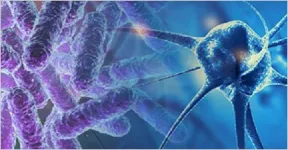(Press-News.org) Primates, including humans, have larger brains than most other mammals, but why? Scientists searching for the answer have long followed a trail pointing to diet—specifically fruit—as the reason for why primates evolved larger brains. A team from the Max Planck Institute of Animal Behavior and the Smithsonian Institute of Tropical Research tested this idea for the first time—finding that the fruit-diet theory might be out of juice. The researchers used drone imaging, GPS tracking, and fine-scale behavioral analyses to test how four species of fruit-eating mammals solved the same natural foraging puzzle in a Panamanian rainforest. They found that the larger brained primate species did not solve the fruit-finding puzzle more efficiently than smaller brained mammals. The study, published today in Proceedings of the Royal Society B, upends the traditional view that a large brain is needed to make smart decisions when finding food.
According to the leading theory for how primates evolved larger brains, fruit and intelligence worked hand in hand to power brain growth. Larger brained animals could use their intelligence to find fruit more efficiently, which in turn provided more energy to fuel a larger brain.
Fruit, after all, is a valuable but variable resource. It places cognitive demands on animals who must find fruiting trees and remember when they ripen. Studies have lent support for the dietary theory of brain evolution by showing correlations between brain size and the amount of fruit in the diet.
But researchers from MPI-AB and STRI thought that the theory was ripe for questioning. “The fruit-diet hypothesis had never been supported experimentally,” says first author Ben Hirsch, a STRI research associate.
Testing fruit-eaters in Panama
The barrier has been methodological. To test the fruit-diet hypothesis, scientists must measure how efficiently an animal finds fruit. Says Hirsch: “Primates and many other mammals travel long distances every day in search for food, making it almost impossible to replicate their real-world navigation challenges in a lab.” The team circumvented this problem by exploiting a natural phenomenon that occurs in the rainforest on Barro Colorado Island in Panama. For three months every year, fruit-eating mammals are forced to feed on one tree species, Dipteryx oleifera.
“With animals feeding almost exclusively on Dipteryx fruit, they are simultaneously solving the same foraging puzzle,” says senior author Meg Crofoot, a director at MPI-AB and Humboldt Professor at the University of Konstanz. “This gives us a powerful tool for comparing their foraging efficiency.”
The team mapped the location of all Dipteryx trees on Barro Colorado Island by flying drones over the canopy in summer, when the tall trees were crowned with conspicuous purple blossoms. The fruit tree map revealed the full extent of the fruit puzzle faced by animals, but the scientists still needed to test how efficiently mammals with different brain sizes visited these trees. They tracked several individuals of two large-brained primates (spider monkeys and white-faced capuchins) and two smaller-brained raccoon relatives (white-nosed coatis and kinkajous). GPS sensors revealed the paths that animals took to Dipteryx trees, while accelerometers confirmed that an animal was active, and potentially feeding, during a tree visit.
The scientists then calculated route efficiency as the daily amount of time spent active in Dipteryx trees divided by the distance travelled. According to the fruit-diet hypothesis, the big-brained capuchins and spider monkeys should exhibit greater route efficiency than the coatis and kinkajous.
“We didn’t find any evidence that animals with larger brains made smarter foraging decisions,” says Crofoot. “If larger brains do make animals smarter, then this intelligence is not being used to route themselves more efficiently to fruit trees in this tropical rainforest.”
So why did brain size increase in some species? The authors say that by refuting the fruit-diet hypothesis, their study can shift the focus to ideas beyond foraging efficiency. “Larger brains might promote better episodic memory, allowing those species to better time tree visits to maximize the amount of ripe fruit encountered,” says Hirsch. The authors also suggest that larger brains might be linked to tool use, culture, or the complexity of living in a social group.
“Our study can’t determine the exact drivers of brain evolution,” says Crofoot, “but we have been able to use minimally-invasive techniques to empirically test a big hypothesis about evolution, cognition, and behavior of wild animals.”
END
Smarter foragers do not forage smarter
Why do primates have big brains? In the Panamanian rainforest, scientists pitted large-brained primates against smaller-brained mammals to find out who was the smartest forager
2024-05-29
ELSE PRESS RELEASES FROM THIS DATE:
A unified account of Darwinism’s varieties
2024-05-29
A new paper published in The Quarterly Review of Biology examines the question of what Darwinism is and how its nonscientific uses relate to the scientific theory of evolution.
Charles Darwin published On the Origin of Species in 1859 as a work in biology. However, in the past century and a half, Darwin’s ideas have impacted a broad range of domains and stimulated scientists and scholars to advance "evolutionary approaches" in domains as diverse as economics, engineering, psychology, and history. The ideas have been used (and abused) to undermine religiously inspired ideas about the origin of humans and their status concerning other species, ...
Marketers can manage 'feature creep'
2024-05-29
AUSTIN, Texas — Wifi-enabled washing machines. Voice-controlled microwaves. App-enabled TVs, vacuum cleaners, and even window blinds you can control from the comfort of your couch.
Many of the technological features now included in everyday products are useful and accessible. But research has shown that having too many can overwhelm potential buyers, making them less likely to make a purchase.
In new research, Wayne Hoyer, marketing professor and James L. Bayless/William S. Farrish Fund Chair for Free Enterprise at Texas McCombs, digs into the phenomenon of “feature creep” and its impact on consumer sentiment. ...
Intermittent fasting shows promise in improving gut health, weight management
2024-05-29
A new study by researchers from Arizona State University and their colleagues highlights a dietary strategy for significant health improvement and weight management.
Participants following an intermittent fasting and protein-pacing regimen, which involves evenly spaced protein intake throughout the day, saw better gut health, weight loss and metabolic responses. These benefits were notably greater than those seen with simple calorie restriction.
The findings, reported today in the journal Nature ...
Scientists identify gene that could lead to resilient ‘pixie’ corn
2024-05-29
AMES, Iowa – A widely found gene in plants has been newly identified as a key transporter of a hormone that influences the size of corn. The discovery offers plant breeders a new tool to develop desirable dwarf varieties that could enhance the crop’s resilience and profitability.
A team of scientists led by Iowa State University spent years working to pinpoint the functions of the gene ZmPILS6. Now, they have been able to characterize it as an important driver of plant size and architecture, a carrier for an auxin hormone that helps govern growth in roots below ground and shoots, or stalks, above ground. Their findings were published in the Proceedings ...
Utilizing medical assistants to manage patient portal messages shown to support practice and physician efficiency
2024-05-28
Many primary care clinicians directly receive messages from patients via electronic health records’ portal inboxes. The COVID-19 pandemic saw a rapid uptick in this trend. Data suggests that this additional work is linked to clinician burnout. Penn Family Care, a primary care group at Penn Medicine, instead routed incoming messages to certified medical assistants who had been taught how to distribute each message to the most appropriate physician. There was a 40% decrease in the number of messages going directly to primary care physicians, and both practice and clinician efficiency showed improvement after adopting this team-based care model.
Utilizing Medical Assistants ...
Study shows clinic continuity associated with reduced hospital and emergency visits
2024-05-28
Background and Goal: Relational continuity, the ongoing relationship between a patient and a family physician, is linked to better patient care, fewer unnecessary procedures, hospitalizations, emergency department visits, and lower costs, along with higher patient satisfaction. With the rise of part-time practices, patients often see multiple family physicians within the same clinic. This study aimed to explore how continuity in a primary care clinic—separate from individual physician continuity—affects patient ...
Recognizing the range of experiences among individuals of Latino, Hispanic, and/or Spanish origin is an essential step toward health equity
2024-05-28
Background: Currently, people of Latiné/e/x/o/a, Hispanic, and/or Spanish (LHS) origin make up 19.1% of the population of the U.S. There is great variation in the personal experiences and family backgrounds of LHS individuals, including differences in country of origin, time in the U.S., colonization histories and immigration experiences.
Key Argument: This essay considers the importance of recognizing the heterogeneity of lived experiences among LHS populations in the U.S. in a health care context.
Why ...
study reveals decline in reported medicare outpatient procedures by family physicians amid an aging population
2024-05-28
Background and Goal: Family physicians perform a wide range of procedures outside the hospital and tend to be office based. Examples may include surgical procedures such as excisions, suturing, and joint injections. Since the training can vary substantially, the Council of Academic Family Medicine (CAFM) issued a statement on which procedures they recommend physicians be able to perform competently upon completion of a family medicine residency. The aim of this study was to determine the extent to which family physicians perform CAFM-recommended procedures for Medicare Part B, the outpatient portion ...
COVID-19 pandemic leads to drop in breast cancer screenings, especially among older and racial minority women
2024-05-28
Background and Goal: Breast cancer is the second most common cancer among women in the U.S. Early detection of the disease through screening can greatly improve the chances of successful treatment and is an essential preventive service in primary care. The COVID-19 pandemic interrupted breast cancer screening as many screening programs were temporarily suspended due to personal concerns about exposure to the virus and the burden on the health care system. The goal of this study was to use real-world electronic health records (EHR) across the U.S. to examine the changes in breast cancer screening utilization since the COVID-19 pandemic and how the follow-up screening rates were impacted ...
Translating the Surgeon General’s framework on social isolation and loneliness to actionable steps in primary care
2024-05-28
Background & Goal: Prior to the COVID-19 pandemic, 20% of adult primary care patients identified as lonely, representing a higher prevalence than many diseases commonly seen in primary care such as diabetes. Social isolation and loneliness are increasing over time, which is not only associated with increased health care utilization in primary care patients, but also with increased risk of chronic health conditions. Social isolation is reported to be equivalent to smoking 15 cigarettes per day in terms of premature death. The U.S. Surgeon General recently released an advisory entitled, “Our Epidemic of Loneliness and Isolation,” presenting a framework for action ...
LAST 30 PRESS RELEASES:
UVA’s Jundong Li wins ICDM’S 2025 Tao Li Award for data mining, machine learning
UVA’s low-power, high-performance computer power player Mircea Stan earns National Academy of Inventors fellowship
Not playing by the rules: USU researcher explores filamentous algae dynamics in rivers
Do our body clocks influence our risk of dementia?
Anthropologists offer new evidence of bipedalism in long-debated fossil discovery
Safer receipt paper from wood
Dosage-sensitive genes suggest no whole-genome duplications in ancestral angiosperm
First ancient human herpesvirus genomes document their deep history with humans
Why Some Bacteria Survive Antibiotics and How to Stop Them - New study reveals that bacteria can survive antibiotic treatment through two fundamentally different “shutdown modes”
UCLA study links scar healing to dangerous placenta condition
CHANGE-seq-BE finds off-target changes in the genome from base editors
The Journal of Nuclear Medicine Ahead-of-Print Tip Sheet: January 2, 2026
Delayed or absent first dose of measles, mumps, and rubella vaccination
Trends in US preterm birth rates by household income and race and ethnicity
Study identifies potential biomarker linked to progression and brain inflammation in multiple sclerosis
Many mothers in Norway do not show up for postnatal check-ups
Researchers want to find out why quick clay is so unstable
Superradiant spins show teamwork at the quantum scale
Cleveland Clinic Research links tumor bacteria to immunotherapy resistance in head and neck cancer
First Editorial of 2026: Resisting AI slop
Joint ground- and space-based observations reveal Saturn-mass rogue planet
Inheritable genetic variant offers protection against blood cancer risk and progression
Pigs settled Pacific islands alongside early human voyagers
A Coral reef’s daily pulse reshapes microbes in surrounding waters
EAST Tokamak experiments exceed plasma density limit, offering new approach to fusion ignition
Groundbreaking discovery reveals Africa’s oldest cremation pyre and complex ritual practices
First breathing ‘lung-on-chip’ developed using genetically identical cells
How people moved pigs across the Pacific
Interaction of climate change and human activity and its impact on plant diversity in Qinghai-Tibet plateau
From addressing uncertainty to national strategy: an interpretation of Professor Lim Siong Guan’s views
[Press-News.org] Smarter foragers do not forage smarterWhy do primates have big brains? In the Panamanian rainforest, scientists pitted large-brained primates against smaller-brained mammals to find out who was the smartest forager



